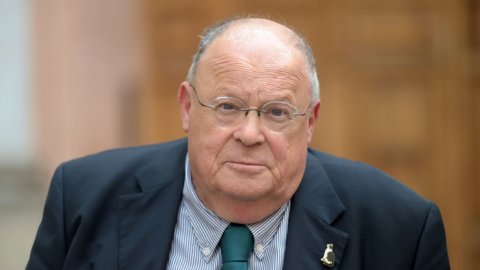Will justice finally be done in the budget law for 2019? They will be cut the golden pensions of those freeloaders who exceed 4 thousand euros net per month? Even on this issue, which has fueled beyond all limits that social envy that has become the dominant sentiment of our (un)civilized life, the forces of the majority are divided. And yet, attentive as they claim to be to the contents of the contract, they would have something to orient themselves, albeit vaguely.
Let's read together the device. "For greater social equity, we also believe it is necessary to intervene aimed at cutting the so-called golden pensions (above 5.000,00 euros net per month) not justified by the contributions paid". In truth, in these few and laconic lines there are only two aspects that seem clear: the cut should apply for treatments that exceed the indicated limit (later reduced to 4 thousand euros net); only services not justified by contributions would be affected.
For the technical modalities of the intervention the address is not clear, even if the frequent references to the recalculation have led to the belief that the model to be followed also for the golden pensions would have been the one adopted in the tampering with the annuities of former deputies. Then, at the beginning of August, the Pdl (AC 1071) conquered the scene on the Circus Barnum trail with the joint signature of the two group leaders of the majority in the Camera D'Uva (for the M5S) and Molinari (for the Lega ).
It didn't take much to notice that the recalculation (even if proclaimed at full blast) ndid not take into account the contributions paid, but the age of retirementending, in fact, by penalizing retroactively those seniority benefits in defense of which the League had brought down two governments (in 1994 and 2011) as well as future ones, the same ones in favor of which the government contract provides for a change substantial part of the Fornero reform (the now known quota 100 and quota 41).
As long as they exceed 80 euros gross per year and for the fractions paid with the salary calculation. The harshest criticisms of this project came from a money order expert close to the League such as Alberto Brambilla, which, under the aegis of Itinerari previdenziali, published on 14 August a note drafted together with Gianni Geroldi and Antonietta Mundo. It is enough to read the premise of the document to understand how radical the dissent of the authors is towards the D'Uva-Molinari PDL.
Premise - The recalculation of the so-called golden or privileged pensions, applying the contribution calculation method, as provided for by the Draft Law (PdL) presented by the Lega and M5S on 6 August 2018, in article 1, is absolutely not a recalculation but only a reduction of pensions based on the ratio between the transformation coefficients relating to the effective retirement age and those relating to the retirement age established in table A, attached to the PdL; in practice the whole operation is based exclusively on retirement ages with heavy penalties for old-age pensions and those with 40 years of contributions. All of this implies a retroactive remodulation of the rules and is therefore an operation that can present a breach of the certainty of the law and profiles of unconstitutionality. Furthermore, especially for pensions starting from 2019, the reference point is the requirements set out in the Fornero reform, precisely the one that the two parties in government wanted to cancel and which instead is further strengthened in peius. Finally, defining these services as golden or privileged, as well as being technically incorrect, tends to make them perceived as an injustice and therefore undermines social cohesion, an indispensable factor in a complex society like the current one.
The alternative proposal is to a solidarity contribution to which all pensions would be subject starting from €2.000 gross per month (of which 0,40% would be paid to the non-self-sufficiency fund and the rest to the employment fund) which would progressively grow up to 12%-15% for more elevated; the contribution would be calculated on the basis of the individual pension brackets (not on the total amount) and would have a limited duration of three years, in order to initiate the establishment and operation of the aforementioned funds. And not to incur the sanction of the Consulta.
As far as we know, the parliamentary Pdl initiative on gold pensions remains "awaiting trial", while, in the last few hours, the position regarding the determination of the 100 quota has changed, which should anticipate the application of the quota 41. Matteo Salvini - once again invading the powers of the Ministry of Labor - declared that there will be no age limits (while a minimum age of 64 was assumed for access).
Which of course has an impact on the extent of the required financial coverage. According to Stefano Patriarca, head of the consultancy company Tabula, allowing access to the pension with the 100 quota (the sum of age and contributions, in any case setting a minimum of 35 years of payments) could cost 2019 billion in 11,5 to reach to almost 15 when fully operational, the third year since the start of the legislation.
In 2017 – as Patriarca himself explained – about 290.000 new direct social security pensions were paid out by INPS in the private sector alone, including around 160.000 seniority pensions. On average, those who retired early were 61 years old. "If, in addition to the 100 quota, the possibility of leaving with 41 years of contributions regardless of age was also envisaged - concluded Patriarca - the cost in the first year would be 12,3 billion and almost 16 billion when fully operational".
The new legislation - according to INPS estimates - it would widen the range of early treatments by 750 thousand units already in the first three-year period of application. But every day has its worth. So within a few hours Salvini fired another one. There will be a minimum age but at 62 years old. This means that starting from 38 years of payments, at 62, it will be possible to retire. There will therefore be a further flourishing of early retirement. And the costs? Here they are according to the various hypotheses of the fervent yellow-green imagination.
Summarizing. With Salvini's new idea, in 2019 there would be 11,2 billion and a greater number of treatments between 350 and 400 thousand. Then there is the question of opportunity. In view of the presentation of the budget law, does it make sense to breathe without thinking about what is being said?





